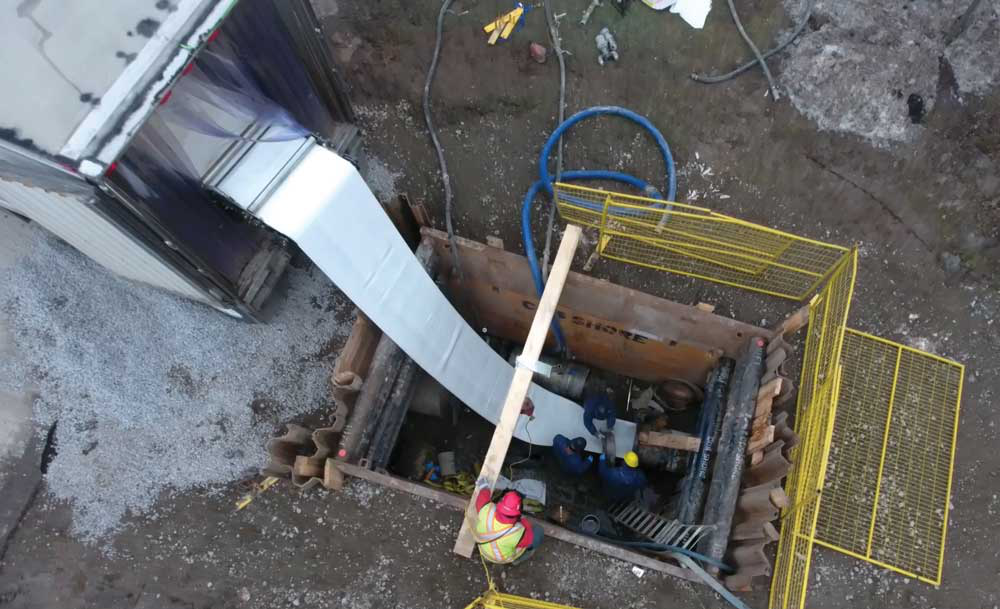Emergency Watermain Repair Requires Trenchless Approach

One benefit of cured-in-place pipe (CIPP) lining that is often overlooked is the speed that a project can be completed. This was highlighted during a project that the City of Markham completed in late 2020.
Project Background
The City of Markham sits directly north of the City of Toronto in Ontario. Its water comes from Lake Ontario, it is treated in Toronto and water storage and increased pressurization is handled by the York Region. The City’s Waterworks Department provides the distribution to more than 320,000 residents.
In November of 2020, the City suffered a significant failure of a critical 600-mm phoenix concrete-coated steel watermain main that crossed underneath a creek. The main had suffered a blow out about 2 in. in diameter. Not only was it located in a difficult location, it also was responsible for providing several essential customers’ water, including that of the Revera Glynnwood Retirement Residence. This was a large concern for the City given that it was during the second wave of COVID-19 where access to safe clean drinking water was more essential than ever.
As soon as the failure occurred, Barry Budhu, Manager of Infrastructure at the City of Markham, jumped into action looking to find a solution. Reaching into his rolodex of contacts, he was able to find a solution to both of his major concerns, providing potable water immediately while also fixing the critical main that had failed. He reached out to local watermain rehabilitation specialist, FER-PAL Infrastructure, as it had the ability to provide immediate temporary water while also the potential to give the pipe a new life.
FER-PAL worked with the City to expedite the construction of a temporary insulated water system. The system was built over the course of several days, and once samples had passed, was placed in service. The watermain was throttled back to minimize the water loss while also maintaining service to the critical customers, including the retirement residence. The main was fully shutdown once the temporary system was placed in service.
CIPP: The Time Saving Solution
With the temporary system in place, the City then turned its attention to the 600-mm watermain to see if FER-PAL could rehabilitate the existing system.
During a typical open-cut replacement of an aging watermain, a large amount of time and costs are allocated to the design of the new pipe. This replacement requires advance design and planning. In addition to this, projects may require subsurface utility engineering (SUE), soil sampling and surveying amongst other services. Each with an additional cost and delay. By installing CIPP, these costs and delays are avoided as a brand-new pipe, with a 100-year lifespan, is built inside an already existing main.
Within a matter of weeks, the City and FER-PAL had developed a plan to install a CIPP liner within the watermain beneath John Street – from Johnson Street to the Candice gate/Baywood Gate intersection.
The Installation
The watermain had failed in a precarious location meaning that the installation would prove to be difficult. Not only did the watermain cross a creek it also travelled through two consecutive 45-degree bends. The total length that the City proceeded to rehabilitate was 516 m. In addition to this with winter temperatures steadily approaching, the need had to be put back into service as soon as possible.
The project team elected to proceed with the ALTRA2 (formally Aqua-Pipe) CIPP liner. The ALTRA products are available into three segments; ALTRA10, ALTRA10X and ALTRA2, which is designated for pipes larger than 12 in.
Having previously installed it at larger sizes, ALTRA2 was proven to be agile enough to install in situations like this. In addition, it had a proven track record and testing to ensure the resiliency and flexibility required to ensure if the host main shifted in the future, that the liner. With such a quick turn around time required, it took an extraordinary amount of planning and coordination with the team of Neidner and Sanexen Environmental, which manufacture the product.
The watermain was cut, dewatered, cleaned and inspected robotically over the course of a week. While the main was cleaned and inspected, FER-PAL worked with Cliff’s Welding to weld flanges to the termination points to allow for reassembly with ductile iron pipe filler pieces.
Following this, the main was set for lining. Due to the added difficulty of the bends as well as size of the ALTRA2 liner, FER-PAL elected to use a reinforced winch to ensure the liner was successfully installed. The 516-m section was lined within five days, which was followed by reassemble the newly rehabilitated main. The main was successfully placed back into service in less than 30-days from the initial failure.

Summary
There is never a good time for a 600-mm watermain to fail but there is certainly a terrible time. Many would agree that amid a global pandemic, as frigid winter temperatures approached, would meet that definition of terrible. The City of Markham recognized this and jumped into action immediately.
Understanding the weight of the situation, FER-PAL’s team worked 10-hour days, seven days a week to ensure the project was completed posthaste.
In the end, the full project only took 34 days to complete, a record for Fer-Pal given the size and complexity of the project. A true success for those involved, the ALTRA2 liner, and the trenchless industry.
